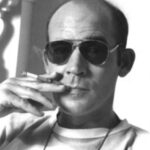The 1960s were a time of political upheaval and international as well as domestic tensions that led to artistic experimentation in every genre of media. The decade is the marker for what many call the “end of innocence” in the United States. The 1960 wasn’t necessarily the birth of irony, cynicism, and satire in American culture, but it was the first time they were introduced and grudgingly accepted by the mainstream culture. A great deal of what was brought to the culture during the decade had already existed in small pockets, but the 60’s pushed society’s limits bringing disparate elements of once silenced counter cultures into the mainstream. The uncertainty that war in Vietnam brought, and the uneasyness Europeans felt as nation after nation fell to communism, and nuclear brinkmanship that brought the world to the each of destruction gave young people and artists the urgency to push the boundaries of the culture while they still could. In America, the young generation rebelled against the homogeneity of the post war ultra conservative 1950s. In Britain, young people rebelled against the thought of losing their heritage to the American conservative, consumer culture. Stability and conformity in the western world became dirty words to the young generation. This generation’s new idol, the rock star, led his disciples like a prophet would a thousand years previous. Musicians broke molds, actively used and condoned drug use, and thumbed it’s nose at the rules of the old guard of society — young people quickly followed suit. Radical film makers thumbed their nose at Hollywood conventions and the traditional rules of storytelling. Mod culture along with pop art thumbed its nose at everything in popular culture before it. The 1960s were a decade of turmoil, upheaval, and chaos that rewrote Western society bringing counter culture to the mainstream for the first time.
The decade cannot be examined without the context of music. Music defined the era, and the lyrics of that music defined the attitudes of its listeners. In 1965, Barry McGuire sang, “Tell me over and over and over and over again my friend, you don’t believe we’re on the eve of destruction.” He challenged his listeners, the young generation to look at the world as if it was not falling apart before their eyes on television every night. He knew as well as his listeners that that was impossible. The last threads of sanity that young people could cling to was popular culture, but like everything else in 1960’s society, the stability of pop culture was wearing away as well. Young people grew disenchanted with the well coifed, glamorous Hollywood stars and starlets of the 1950s. Looking for direction they found new idols to worship in rock and roll’s stars, particularly the bands of the British Invasion.
The rock star was the most powerful force of the 1960s, and young people were divided into two camps symbolized by their allegiance to two bands: The Beatles and The Rolling Stones. The Beatles were a cultural phenomenon accepted by a majority of the mainstream youth culture. The Rolling Stones were their more raw, rebellious alternative. Though unlike any other decade previous, the two major divisions in youth culture were not between liberals and conservatives or Elvis and Pat Boone. In the 1960s, both divisions of the culture were anti-establishment, anti-conservative, and counter culture. Both bands were denounced by the older generation, and both Lennon/McCartney of the Beatles and Jagger/Richards of the Stone’s led their eager disciples through a quest for free love, mind expansion, and freedom from all inhibitions. They advocated and publically participated in drug use in their own lives as well as popularizing it in songs like “Doctor Robert”, “Day Tripper”, and “She Said, She Said”.
The Beatles and Stones evolved with the culture of the 1960s, and some may argue that they shaped its evolution. In 1967, The Beatles experimented with psychedelica on their album “Revolver” as the hippy culture that followed them experimented with the newly discovered perception altering drug LSD. Psychedelic art gained popularity as a way to capture the feeling and essence of hallucinogenic drugs. The Stone’s listener’s drug of choice was marijuana, which fit the band’s more dark and brooding persona. The band and its followers slowly pushed the limits of the society’s traditions further and further. In 1963, many thought it was outrageous for the band members to have long hair. In 1967, Mick Jagger and Keith Richards were in the English press after being arrested on drug possession charges. By 1969, Brian Jones abused enough substances to kill himself. Jones’s death can be a seen as a metaphor of the decade – one that started as an innocent extension of the 1950s and ended in chaos and cultural burnout.
The cover art for The Rolling Stone’s album Sticky Fingers, interestingly enough was designed by New York artist Andy Warhol. The artists of the 1960’s hoped to move away from making art with details to interpret instead opting to create art with a message to interpret. Pop art was born out of this desire, and it becomes a metaphor for the decade’s separation and rejection for the culture that came before it. Pop art developed in large, metropolitan areas full of bohemian intellectuals who used their art to essentially turn popular, cherished symbols of decades past (particularly the 1950s) and turn them into satires of consumerism, and idol worship. “Pop Art emerged in the mid 1950s in England, but realized its fullest potential in New York in the ’60s where it shared, with Minimalism, the attentions of the art world. In Pop Art, the epic was replaced with the everyday and the mass-produced awarded the same significance as the unique; the gulf between ‘high art’ and ‘low art’ was eroding away.”
Embodying the ethic of this art form was Andy Warhol. His work “Cambell’s Soup, Vegetable” features a popular image of a 1950’s Cambell’s soup can familiar to almost everyone in the mainstream culture through advertisements; his painting was statement about the over saturation of advertisement and rampant consumerism of the decade previous. In a similar fashion, he took the image of famous 50’s sex symbol Marilyn Monroe and made a piece about the worship of the Hollywood celebrity. The pop art aesthetic was less about a works artistic value and more about its irony and meaning.
British mod culture transformed pop art into a way of life. Still facing the after affects of World War II – a lack of goods, money, and services – the youth of England turned to the American culture they saw in the movies of the 1950’s for solace. America was the land of plenty not ravaged by the war. British young people started losing their identity in the 50’s, and the fiercely British Mod movement developed as a response during the 1960’s. The movement had it’s locus in Liverpool a town built on rock and roll music. Mod bands like The Kinks and The Small Faces integrated ideas of pop art into their style and music and purely British themes into their lyrics.
Stylistically, the British rock group The Who were disciples of this new culture. On stage, they wore Royal Air Force pins and medals on their shirts and jackets made out of the Union Jack. The band admitted to the press to spending unheard of amount every year on new clothes and instruments. Guitarist Pete Townshend would sometimes smash his guitar at the end of a stage show because of the sound it made through the amplifier while smashing and the effect it would have on the audience. They prided themselves on being the world’s “loudest rock and roll band in the world” taking all of the amplifiers they owned to shows at even the smallest venues. They embodied mod culture in how they dressed and their stage personas, but the real mentality of mod is found more in the music of the Kinks.
The Kinks, especially lead singer/songwriter Ray Davies, set the tone for mod culture in the late 60s with thoughtful, sentimental lyrics about British life. In 1968, British Invasion bands like The Beatles and The Rolling Stones were breaking new musical ground. The Beatles psychedelia influenced, overproduced Sgt. Pepper’s Lonely Heart’s Club Band was released and labeled as a masterpiece. The Rolling Stones countered with the less critically praised, but more forward thinking Sympathy for the Devil. Ray Davies in 1968 was not satisfied with the state of rock and roll. Paving the way for the mod mentality, he wrote a concept album with lyrics that celebrated the old world and not the new: The Kinks Are the Village Green Preservation Society. The album celebrated the achievements of Victorian England, and sought to “preserve the old ways from being abused” as the title song stated. The same year the Stone’s Mick Jagger s sang about Jumping Jack Flash, Ray Davies sang about “tudor houses, antique tables and billiards”. Davies went on to write the rock opera “Arthur, or The Decline and Fall of the British Empire” a thoughtful history of British culture from Victoria through post WWII. The Who wrote their own rock opera which was also made into a film.”Quadrophenia”. It was about the mod culture and alienation and was against the backdrop of riots in 60s Brighton. Where The Who embodied mod style, The Kinks embodied the mod way of thinking.
Rock operas were not the only films being made in the 1960s. Stanley Kubric teamed with Arthur C Clarke to create a provocative piece of experimental film in 1968’s 2001: A Space Odyssey. Based on Clarke’s short story The Sentinel it was a look at the rise of man and asked questions about evolution of man. The film left an equal number of movie goers either baffled or amazed. Kubric considered 2001 to be a “tone poem” rather than a traditional film, as such only 40 out of 140 minutes of the film contains dialog. The film instead relies on its soundtrack and visuals: the juxtaposition between the images of the distant future on the screen and the classical music being played in the background. 2001 had a visual style and an adherence to detail was like nothing in cinema before it. Other films of the 60s were famous less for their art and more for their content. Bonnie and Clyde was the true story of a pair of bank robbing lovers. It revels in its own graphic, realistic portrayal of violence (without being exploitative), especially at the conclusion in a bloody shootout. Mainstream audiences still indoctrinated by the censorship of Hollywood’s Hayes Code weren’t prepared for it’s content when first screened. Where 2001 pushed the boundaries of art in 60s cinema, Bonnie and Clyde broke the boundaries on content.
The culture the 1960 broke boundaries in every way. It took the little it accepted from previous decades and totally discarded the rest. Many of the ideas that came out of the 60s and its radical liberalism were a backlash against the ultra conservativism of the previous decade. The Vietnam war, the spread of communism, and looming nuclear war brought urgency to the world. Rock stars taught the rest of the culture to live for the moment while the moment still existed.
Allen Ginsberg. American Poetry Since 1950: innovations and outsiders: an anthology. Ed. Eliot Weinberger. New York: Marsilio, 1993. 25-29.
Rogan, Johnny. The Complete Guide to the Music of the Kinks. London-New York-Sydney: Omnibus Press, 1998.
Starostin, George. Only Solitaire: The Kinks. RiNet Internet Service Provider. Viewed 11 November 2005.
Johnson, Brian D. “Leaving Normal (review).” Maclean’s, May 11, 1992, v105 n 19 p58(1). 5 October 2000



